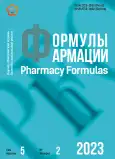Detection of the pesticide glyphosate in feed and ways to reduce its content for poultry
- Authors: Melikidi V.H.1,2, Tyurina T.G.2, Laptev G.Y.2,3
-
Affiliations:
- Volgograd State Agrarian University
- BIOTROPH Ltd
- Saint Petersburg State Agrarian University
- Issue: Vol 5, No 2 (2023)
- Pages: 70-74
- Section: Actual problems: discussion tribune
- URL: https://journals.rcsi.science/PharmForm/article/view/249544
- DOI: https://doi.org/10.17816/phf352545
- ID: 249544
Cite item
Full Text
Abstract
The study considers a way to reduce the content of glyphosate in the gastrointestinal tract of birds using specially selected strains of bacteria as a probiotic. The widespread use of glyphosate, especially in connection with the introduction of GMO-resistant crops on the market, leads to its widespread accumulation in plant feeds, as well as in food consumed by humans. The public is becoming increasingly concerned about the safety of glyphosate, especially in the context of its chronic effects on humans through food — and their alarm is confirmed by the results of a toxicological assessment. The paper analyzes the content of glyphosate in poultry feed samples and suggests a way to reduce the effect of glyphosate on the poultry body by using industrial probiotics. Special strains of probiotics with the property of biotransformation have been studied.
Keywords
Full Text
##article.viewOnOriginalSite##About the authors
Veronika Hr. Melikidi
Volgograd State Agrarian University; BIOTROPH Ltd
Author for correspondence.
Email: veronika@biotrof.ru
SPIN-code: 9799-8818
Postgraduate student, leading biotechnologist
Russian Federation, Volgograd; Saint Petersburg, PushkinTyurina G. Tyurina
BIOTROPH Ltd
Email: biotrof@biotrof.ru
SPIN-code: 9917-5118
Candidate of Economics. PhD, Deputy Director
Russian Federation, Saint Petersburg, PushkinGeorgy Yu. Laptev
BIOTROPH Ltd; Saint Petersburg State Agrarian University
Email: laptev@biotrof.ru
SPIN-code: 3600-5295
Doctor of Biological Science, head of department “Biotechnology of feed”, Director of BIOTROPH Ltd
Russian Federation, Saint Petersburg, Pushkin; Saint Petersburg, PushkinReferences
- Gillezeau C. The evidence of human exposure to glyphosate: a review / Ch. Gillezeau, M. van Gerwen, R. M. Shaffer et al // Environmental Health. – 2019. – 18(2). – p. 1–14. – doi: 10.1186/s12940-018-0435-5.
- Soares D. Glyphosate Use, Toxicity and Occurrence in Food / D. Soares, L. Silva; S. Duarte et al // Foods – 2021. – 10(11): 2785. – P. 1–22. – doi: 10.3390/foods10112785.
- Medvedev O.S. The increasing use of glyphosate in the production of glyphosate-resistant soybean varieties increases the risk of negative effects on human health/ O. S. Medvedev // Agroforum. – 2021. – № 6. – P. 34–35. (In Russ).
- International Agency for Research on Cancer Volume 112: Some organophosphate insecticides and herbicides: tetrachlorvinphos, parathion, malathion, diazinon and glyphosate. IARC Working Group. Lyon; 3–10 March 2015. IARC Monogr Eval Carcinog Risk Chem Hum (in press).
- Guyton Kathryn Z., Loomis Dana, Grosse Yann, et al. Carcinogenicity of tetrachlorvinphos, parathion, malathion, diazinon, and glyphosate //The Lancet: journal. – Elsevier, 2015. – Vol. 16, No. 5. – P. 490–491. – ISSN: 14702045. – doi: 10.1016/S1470-2045(15)70134-8.
- Benbrook C.M. Trends in glyphosate herbicide use in the United States and globally.Environ Sci Eur, 28, 3 (2016). doi: 10.1186/s12302-016-0070-0
- Sorokin A. Glyphosate in plant-based raw materials and feed / A. Sorokin, D. Nekrasov, I. Batov, A. Petrov, L. Kish // Kombikorma. – 2022.– No. 3. – P. 58–60. – doi: 10.25741/2413-287X-2022-03-4-171. (In Russ).
- Ruuskanen S, Rainio MJ, Gómez-Gallego C, Selenius O, Salminen S, Collado MC, Saikkonen K, Saloniemi I, Helander M. Glyphosate-based herbicides influence antioxidants, reproductive hormones and gut microbiome but not reproduction: A long-term experiment in an avian model. Environ Pollut. 2020 Nov;266(Pt 1):115108. doi: 10.1016/j.envpol.2020.115108. Epub 2020 Jul 5. PMID: 32768925.
Supplementary files








